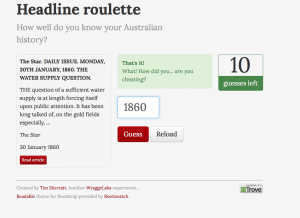This is my last post on the class blog before the end of the unit. I’d just like to thank everyone for a wonderful semester, through the ups and the downs. There were things I got in an instant (success!) but there are also things that still baffle me, with more questions to be answered and possibilities to be explored!
But after everything I’ve learnt a lot and I’m excited to have had new experiences and to have gained new skills and knowledge.
Tim, thank for all your help and support with making the vision for my project a reality.
This is my longest post yet, so see the reflection on my project below the cut!
Over and out,
Jacinta?
Continue reading “Final Post – Reflection on my Digital Heritage Project ?”
